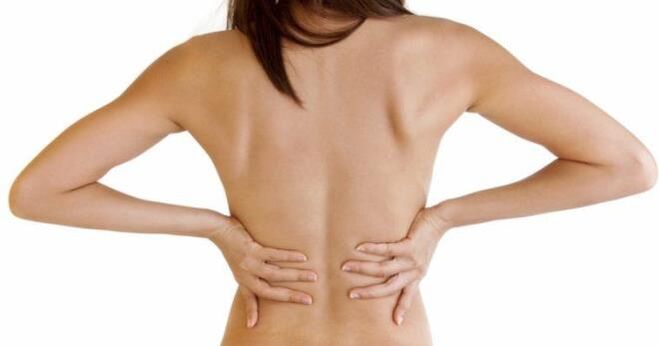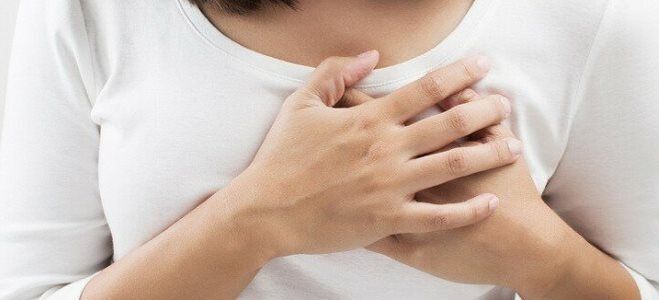
Damage to the thoracic spine is often confused with a pathology of internal organs. The lungs, heart, as well as mammary glands and stomach located here can also provoke pain in this place. Because of this, doctors often find it difficult to diagnose osteochondrosis of the chest region: symptoms in women are mistaken for mastopathy.
Thoracic osteochondrosis - symptoms and sensations
To begin with, it should be noted that osteochondrosis is the most common pathology of the spine. By its nature, it is a degenerative lesion of the intervertebral discs associated with dystrophy. Such processes lead to irreversible changes in the vertebral structure, which affects the functionality of the spine as a whole.
Given the dense innervation and the presence of a large number of nerve roots, patients with osteochondrosis experience severe and sharp pain. At the same time, their nature and intensity may change. This complicates the diagnostic process: to differentiate thoracic osteochondrosis, the symptoms and sensations in women are analyzed, excluding the pathology of the mammary glands, heart and stomach.
The first signs of osteochondrosis in women
Painful sensations stand out among all possible signs of spinal cord injury. Strong, painful pains that intensify at night, when you stay in one position for a long time, are often the first to attract attention. Increased pain is also observed during physical activity with:
- bends;
- sharp turns on the side;
- prolonged physical exercise, even of low intensity;
- deep breathing;
- raising his hands up.
Some patients complain of a feeling of tightness in the chest area. If osteochondrosis of the thoracic spine is suspected, the symptoms in women can be supplemented by a number of signs, these are:
- numbness of certain areas of the epidermis;
- feeling of coldness in the lower extremities;
- pain in the projection of the stomach and esophagus;
- disruption in the functioning of the gastrointestinal tract.

Degrees of osteochondrosis
Symptoms of thoracic osteochondrosis in women mainly depend on the nature of degenerative changes. Taking them into account, the corresponding stages of the disease (degree) are distinguished:
- The first degree - fixed when changes in the core of the disk are observed. Excessive load leads to dehydration of the core, which causes a decrease in the height of the disc and the development of cracks in the area of the annulus fibrosus. There is no pain, some women complain of slight discomfort with prolonged static.
- 2nd degree - due to the decrease in the height of the disc, the distance between the vertebral bodies decreases.The ligaments of the spine eventually decrease. The vertebrae acquire greater mobility, which is not typical for the thoracic region as a whole. As a result, the risk of displacement increases. The pain appears mainly during work. It is directly at this stage that osteochondrosis of the chest region is detected and symptoms in women become apparent.
- Grade 3 - the formation of intervertebral disc prolapses is observed.These phenomena are associated with subluxations and development of arthrosis of the intervertebral joints. Mobility decreases, and numbness and tingling sensations appear in the limbs. Painful sensations are registered in the back, neck and chest region.
- 4th degree - the body tries to compensate for the hypermobility of the vertebrae and adapt to the dysfunction of the spine.Where the vertebral bodies come into contact with each other, osteophytes form, which can cause nerve compression and damage the vertebrae.
How to distinguish thoracic osteochondrosis from other diseases?
According to statistics, osteochondrosis of the thoracic spine, the symptoms of which in women generally do not differ from those recorded in men, occurs less often than lesions of the cervical and lumbar spine. However, this does not make the process of diagnosing the disease any easier. Due to the peculiarities of localization, many doctors confuse the pathology with diseases of the chest organs.
However, experienced specialists who know how to identify osteochondrosis of the chest already in the first stage try to exclude diseases of the breast, heart, stomach and lungs. Thus, there is no cough with thoracic osteochondrosis, unlike the pathologies of the respiratory system, which are always associated with this symptom.
How to distinguish thoracic osteochondrosis from heart pain?
In practice, doctors are often faced with a situation where a patient complains of regular pain in the heart, but the changes in the cardiogram and ultrasound are not recorded. In such cases, painful sensations in the chest on the left are associated with neurological disorders due to osteochondrosis. When the space between adjacent vertebrae decreases, the nerve roots are compressed, which causes painful sensations that mimic a heart attack.
Knowing how to distinguish angina from thoracic osteochondrosis, you can immediately identify myocardial disorders. Among the main differences:
- With osteochondrosis, the pain lasts for hours, weeks and has a wave-like course, subsides and reappears. With angina pectoris, an attack of pain lasts 10-15 minutes, decreases after nitrates.
- The appearance of pain in osteochondrosis does not occur against the background of physical activity, unlike angina pectoris.
- Neurological pain due to spinal cord injury can be alleviated with analgesics, but for patients with heart pathology these drugs are ineffective.
Thoracic osteochondrosis and VSD
Fixed signs of thoracic osteochondrosis in women should be differentiated from the manifestations of VSD. Unlike spine injuries, diseases of the cardiovascular system are characterized by a number of symptoms that should be paid attention to.Among the characteristic signs of VSD:
- tachycardia, heart pain;
- occurrence of asthma attacks;
- unstable blood pressure due to circulatory disorders (pressure with thoracic osteochondrosis is always normal).

Thoracic osteochondrosis and stomach pain
Abdominal pain with thoracic osteochondrosis is provoked by a violation of the innervation of the vertebrae located in the projection of the stomach. If the patient has problems with the stomach, annoying pains appear, accompanied by unpleasant sensations such as heartburn. At the same time, painful sensations are in no way related to activity and physical activity.Pain with thoracic osteochondrosis in the abdominal area has the following characteristics:
- aggravated by movements involving the spine;
- discomfort does not decrease after taking medications that improve digestion;
- appear regardless of stomach fullness: on an empty stomach, after eating.
Thoracic osteochondrosis and pain in the mammary gland
Mastalgia is a common symptom in women. Many girls experience painful sensations in the breasts due to cyclical hormonal changes. However, if there is no cyclical pain, doctors suspect possible changes in the spine. At the same time, women themselves begin to look for the cause on the Internet, trying to understand how to understand that you have osteochondrosis.
In cases where degenerative changes occur in the spine, the pain changes its location and appears regardless of the phase of the menstrual cycle. In this case, there is no swelling or swelling of the breast. The gland itself completely preserves its appearance, size and shape, in contrast to cases where breast pathologies develop. Similar signs of osteochondrosis in women help to differentiate the disease.
What to do with thoracic osteochondrosis?
Suspecting thoracic osteochondrosis in women, doctors send patients for proper examination. This disease diagnosis and correct correction allow us to avoid the negative consequences that are inextricably linked to spinal disorders. A complete diagnosis, which is based on hardware examination data, is important.
Diagnosis of osteochondrosis of the thoracic spine
The main and often the only diagnostic method is chest X-ray. This allows you to diagnose osteochondrosis in women, regardless of the severity of the changes. It all depends on the quality of the photo.When osteochondrosis of the thoracic region is present, the symptoms in women in the photo read as follows:
- violation of the contours of the discs themselves located between the vertebrae;
- modified disc shape;
- the presence of osteophytes (pathological growth);
- spinous processes with sharp edges, irregularly shaped vertebrae;
- the presence of intervertebral hernia.
Treatment of osteochondrosis of the thoracic spine
Therapy for this disease is complex. Treatment of thoracic osteochondrosis is carried out simultaneously in several directions:
- Pain relief- use NSAIDs.
- Strengthening the spine– moderate, balanced physical activity, physical therapy.
- Surgery- when intervertebral hernias appear.













































